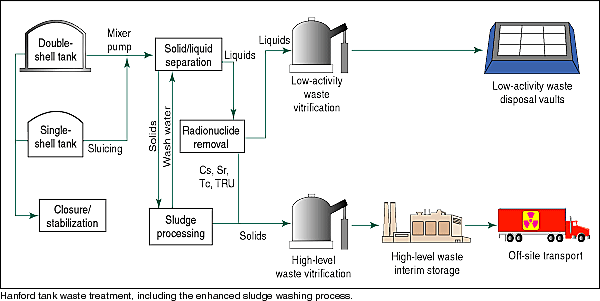

Approximately 350,000 cubic meters of legacy waste from weapons production activities is stored in underground storage tanks on Department of Energy sites, most of it at the Savannah River and Hanford sites, the Oak Ridge Reservation, and Idaho National Engineering and Environmental Laboratory. This waste has a wide range of chemical and physical properties, and a large percentage of it is highly radioactive sludge. A method of pretreating tank sludge already in use at the Savannah River Site (SRS) has the potential to generate immense cost savings at Hanford Site.
At SRS’s Defense Waste Processing Facility, highly radioactive sludge is safely immobilized through vitrification. Some nonradioactive chemicals in the sludge—notably phosphorus, chromium, and sulfate—don’t readily dissolve in molten glass. Keeping these constituents to viably low concentrations in the melter feed drives up the volume of glass to be processed, transported, and disposed. In addition, aluminum—the most common metal in the sludge after sodium—acts as a diluent, producing more glass than necessary. Separating these nonradioactive chemicals from the sludge prior to vitrification can substantially reduce costs and potential risks of exposure.
Some components of tank sludges can be partly removed by simply "washing" with water, but others require a stronger separations process. That’s where "enhanced sludge washing" (ESW) comes in. This slightly oxymoronic label is applied to a combination of water washing, caustic leaching, and other process enhancements for more thorough extraction of undesirable components, leading to improved glass processability and durability while reducing the volume of waste requiring vitrification. ESW takes advantage of the fact that several of the materials, such as aluminum and chromium, are more soluble in highly caustic solutions than in less caustic ones.

Doing the wash
Sludges have a range of textures; some are thick and granular and do not mix easily. In bench-scale ESW tests conducted through the Tanks Focus Area, sludge samples were thoroughly mixed first with "inhibited water" (a diluted caustic solution) and then with a concentrated caustic solution. Washing with inhibited water removed much of the sodium, which also acted as a diluent to the glass. After the concentrated caustic wash, the sludge was again washed with inhibited water to remove much of the remaining sodium added with the caustic. After mixing, the solution was centrifuged to remove the liquids from the solids. This process separated out the nonradioactive components, but the radionuclides—with the exception of cesium—remained in the sludge.
In a full-scale process, sludges can be mobilized and washed in situ as part of retrieval. Solid/liquid separation is accomplished by gravity settling, and the liquid is decanted off the solid. Low-level waste from separations is further treated to reduce radionuclide concentrations, then sent for LLW immobilization and on-site disposal. High-level waste from separations will be vitrified and eventually sent to off-site disposal.
Process improvements during ESW can also control chemical reactions that form gels and precipitates capable of plugging pipes and preventing the transfer of waste between tanks and treatment facilities. Plugged pipes cause process downtime and can expose workers to radioactive materials. Repairs, if possible, are costly. With ESW yet to be implemented, the Hanford Site has had to abandon five waste transfer lines due to plugging.
Several technologies may be deployed in conjunction with ESW, including process monitors and sensors (to indicate when further washing is unnecessary), various chemical treatments to reduce gel formation or increase the solubility of chromium, and novel solid/liquid separation processes to increase the effectiveness of ESW. Advanced separations can be employed at the end of the ESW process to further reduce the HLW volume.
Progress towards deployment
ESW was implemented at SRS in 1993. Sludge is transferred from HLW storage tanks to the Extended Sludge Processing Facility, where it is mixed with caustic and washed to remove aluminum and reduce the concentration of sodium salts. The washed sludge becomes feed to the Defense Waste Processing Facility.
Since 1993, Tanks Focus Area sludge pretreatment studies have included alkaline washes of Hanford and ORNL sludges and partitioning of sludge components by caustic leaching. In 1998, DOE determined that ESW was acceptable for pretreatment of Hanford tank sludges. At the same time, the focus of testing shifted to performing parametric tests on selected sludge samples so that process engineers can optimize full-scale process flow sheets for specific waste types.
Concentrating on savings
Because it adds wash solutions to wastes already in the tanks, sludge washing does increase the total volume of waste to be treated. However, it reduces the HLW portion of waste to be vitrified and enables higher radioactive waste loadings in the glass, so fewer glass logs will have to be created, handled, and stored. These shifts in proportion would more than compensate for the increased total volume because immobilization and disposal of HLW cost on the order of $450 per kilogram of waste oxide, compared to only $15 per kilogram for LLW.
Experts at Los Alamos National Laboratory have calculated and compared estimated probable costs for treating the sludge in Hanford tanks with ESW and with the baseline of simple (water) sludge washing (costs were derived from the Hanford Tank Waste Remediation System environmental impact statement documentation and other documents). Estimated potential cost savings over a period of 30 years are almost $5 billion. To put this figure in context, such savings from this technology alone would equal a roughly 150% return on investment for all Office of Science and Technology activities since the inception of its organizational forerunner 10 years ago.
Potential cost savings estimates for ESW are continually updated as retrieval strategies change and better sludge washing data become available. Data from laboratory-scale tests of sludge washing are being used to develop blending strategies. The latest study estimates 1,800 cubic meters of HLW glass will be produced in the Phase I baseline at Hanford. For Phase II, HLW volume estimates range from 9,500 cubic meters (for a total-blend strategy) to 18,600 cubic meters (for a no-blend strategy). At a cost avoidance of $940,000 per cubic meter for HLW immobilization and disposal, the cost savings from blending strategies optimized on the basis of ESW studies could be as high as $8.6 billion.
More work remains to be done:
- Investigating removal of aluminum from the LLW as a solid before ion exchange and treating this solid as LLW, reducing the processing complexity of the radionuclide removal and the volume of both HLW and LLW.
- Evaluating the need for and availability of process monitoring and control technology. In-tank sensors that can monitor the concentration of soluble constituents in real time are under development.
- Evaluating methods to increase the solubility of chromium in alkaline processes. Oxidizers such as ozone and permanganate are being tested to increase the solubility of chromium.
- Testing processes to increase sludge separation, such as performing solid/liquid separation and ESW at elevated temperatures.
- Testing process parameters or chemical additions to prevent formation of aluminosilicate gels and precipitates.
Contacts for further information:
Rodney Hunt, Principal Investigator–Oak Ridge National Laboratory, (865) 574-5481, huntrd@ornl.gov
Gregg J. Lumetta, Principal Investigator–Hanford, (509) 376-6911, gregg.lumetta@pnl.gov
C. Phil Mcginnis, Tanks Focus Area Technical Integration Manager for Pretreatment, (865) 476-6845, cpz@ornl.gov
Ted P. Pietrok, DOE–Richland Tanks Focus Area Lead, (509) 372-4546, theodore_p_pietrok@rl.gov
Donald J. Temer, Principal Investigator–Los Alamos National Laboratory, (505) 667-9636, dtemer@lanl.gov